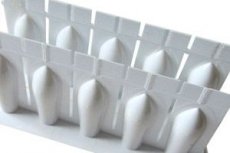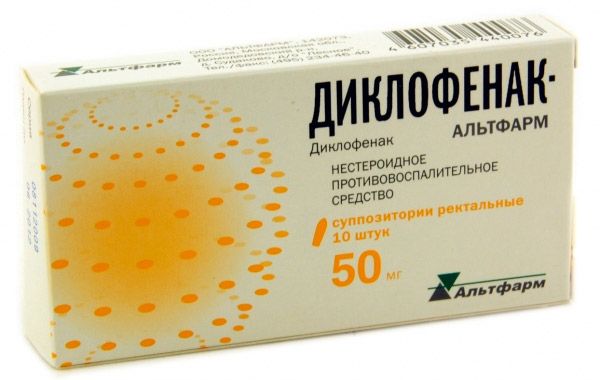Medical expert of the article
New publications
Preparations
Pain relieving suppositories after childbirth
Last reviewed: 03.07.2025

All iLive content is medically reviewed or fact checked to ensure as much factual accuracy as possible.
We have strict sourcing guidelines and only link to reputable media sites, academic research institutions and, whenever possible, medically peer reviewed studies. Note that the numbers in parentheses ([1], [2], etc.) are clickable links to these studies.
If you feel that any of our content is inaccurate, out-of-date, or otherwise questionable, please select it and press Ctrl + Enter.

A woman carries her baby for nine months, anxiously and joyfully awaiting the crucial moment – the birth of the child. Childbirth is a natural process, accompanied by a colossal load on the female body. Hormonal changes, physical pain and psychological stress are factors that invariably accompany the woman in labor. If the birth is the first, or repeated and rapid, the baby is large or the obstetrician-gynecologist was not qualified enough to conduct natural childbirth, then complications arise in the form of internal and external cracks, tears in the vagina and perineum. The causes of these complications can also be underdevelopment of the vagina (narrow and short), illiterate use of obstetric forceps or a vacuum extractor. Tears are eliminated by suturing. Subsequently, rough and painful scars may remain, interfering with normal life. To prevent craniocerebral injuries of the infant and spontaneous ruptures of the vagina or perineum of the mother in labor, obstetric surgical tactics of labor management are used - episiotomy. The perineum and the back wall of the vagina are surgically dissected. After the birth of the child, the edges of the incisions are connected and fixed with sutures.
When applying sutures in the perineum and vagina, it is necessary to carefully observe the rules of personal hygiene. Conduct measures aimed at preventing pathogenic microflora from getting onto the sutures and their suppuration.
After childbirth, a woman may be bothered by pain and bleeding from injured hemorrhoids. This fact has a very negative effect on the general condition of the woman in labor.
In puerperium, intense, constant aching and obsessive pain in the perineum, lower back pain after epidural anesthesia, pain in the anus and rectum after trauma to hemorrhoids, pain associated with cesarean section delivery. A few weeks after delivery, the woman's reproductive organs will return to normal. The uterus will contract, the pain and swelling of the perineum will pass, and mother and child will be able to enjoy each other's company.
The pain factor has a negative impact on the regulation of the lactation process and the psychological state of the woman in labor. A woman in the postpartum period is emotionally unstable and is in a very stressful state, so it is very important to relieve and eliminate pain. To determine the type of pain relief (tablets, suppositories, injections), a specialist consultation is necessary. The attending physician will be able to adequately assess how much the benefit to the mother exceeds the potential risks of developing side effects in the newborn. Self-medication is unacceptable and can have unpredictable and dangerous consequences. Rectal and vaginal suppositories can be used for pain relief in puerperium. They have both general and local anesthetic effects. They have an anti-inflammatory effect. The names of pain-relieving suppositories permitted in the postpartum period are as follows: Ketorol, Ketanol, DicloF, Diclofenac, Voltaren.
The most effective pain-relieving suppositories successfully used in gynecological practice after childbirth are rectal suppositories Diclofenac.
Indications of pain medication after childbirth
- Degenerative, destructive post-traumatic acute and chronic diseases.
- To eliminate edema and pain syndrome in the postoperative period.
- Gynecological practice: postpartum period, algomenorrhea (diclofenac can eliminate pain syndrome and reduce the severity of blood loss).
- Neurology: relief of acute back pain, migraine-like headaches, tunnel syndromes.
Pharmacodynamics
Active ingredient – sodium diclofenac. Belongs to the group of non-steroidal anti-inflammatory drugs, is an effective multifunctional agent used in various areas of medical practice. Diclofenac has antiphlogistic, analgesic and antipyretic effects.

Anti-inflammatory activity is based on the suppression of the synthesis of bioactive compounds that accompany any inflammatory process in the body. Diclofenac significantly inhibits the secretion of substances that contribute to the occurrence of an active inflammatory process, an increase in body temperature and a pain factor.
The analgesic effect is explained by the ability of diclofenac sodium metabolites to influence the intensity of pain sensations by affecting the degree of irritation of certain receptors in the brain. In addition to suppressing the central signal, the drug also affects the sensitivity of peripheral receptors, i.e., it can be concluded that the drug Diclofenac achieves an analgesic effect by interrupting the impulse in different levels of the chain of occurrence of the pain signal.
Pharmacokinetics
With rectal administration, rapid and complete absorption of the active ingredient into the bloodstream is observed. After 0.5 - 1 hour after administration, the concentration of the substance in the blood reaches its maximum level, which is much faster than with oral administration of sodium diclofenac tablets (2-4 hours). It is transformed by the liver into active metabolites that affect the receptors of neuronal tissue. Inactive derivatives of diclofenac are excreted from the body mainly by the kidneys (65%) and partly by the intestines (30%).
In patients with chronic functional hepatitis and cirrhotic changes in the liver, with impaired renal function, no pharmacokinetic features were observed.
In moderate cases of impaired renal filtration function, it is characterized by an increase in clearance time. Diclofenac does not accumulate in the body. It penetrates into breast milk and synovial fluid.
Dosing and administration
Diclofenac in the form of rectal suppositories has advantages over enteral and parenteral administration of the drug. Suppositories do not cause complications that are possible with injection (infiltrates, abscesses) and are absorbed much faster than tablet forms. Rectal suppositories do not irritate the mucous membranes of the stomach and duodenum, the activity of the drug is less affected by the barrier function of the liver. The daily dose of the drug should be calculated by the attending physician depending on the problem that has arisen (no more than 150 mg / day).
Before using suppositories, it is recommended to cleanse the intestines so that the main active substance is absorbed. Remove the suppository from the contour plastic packaging. It is necessary to insert the suppositories into the anus as deeply as possible. It is advisable to do this manipulation at night or after insertion you should lie down for 20-30 minutes. In obstetric and gynecological practice (cesarean section and for pain relief after childbirth), the use of diclofenac is recommended in cases where the benefit to the mother outweighs the possible risks to the child. Self-medication in obstetrics can significantly worsen the condition of the woman in labor. Therefore, the selection of means and methods of pain relief after childbirth should be entrusted to a qualified doctor.
The daily dosage, according to the instructions, is: 1 suppository (Diclophenacum 0.1 g) rectally once.
The duration of the course of treatment and the dose of the drug are determined by the doctor individually, taking into account the dynamics and tolerability of the therapy.
 [ 17 ]
[ 17 ]
Contraindications
- hypersensitivity to diclofenac or other non-steroidal drugs (possibly "aspirin triad");
- destructive and inflammatory changes in the mucous membrane of the upper gastrointestinal tract (erosions, ulcers of the stomach and duodenum in the acute phase of manifestations or accompanied by obvious or hidden bleeding);
- exacerbation of proctitis and paraproctitis;
- worsening of hemorrhoids, accompanied by bleeding;
- disorder of hematopoiesis of unknown genesis;
- conditions accompanied by suppression of hematopoiesis – aplastic or hypoplastic anemia, thrombocytopenia;
- acute liver diseases;
- acute kidney diseases accompanied by a profound impairment of filtration capacity;
- children under 16 years of age;
- pregnancy (especially the third trimester);
- lactation period (if a long course of treatment with diclofenac is required, it is recommended to stop breastfeeding);
- presence of confirmed hyperkalemia.
Risk factors for which the doctor should select the prescription and dose of diclofenac especially carefully:
- Age 65 years.
- Hypertension.
- Moderate and severe chronic renal failure with impaired filtration capacity.
- Chronic destructive liver diseases.
- Heart failure.
- Alcohol consumption.
- Smoking.
Side effects of pain medication after childbirth
The drug is usually well tolerated by patients. When administered rectally, local reactions may occur: itching, burning, pain during defecation, mucous discharge mixed with blood, swelling at the injection site;
- hematopoietic system - thrombocytopenia, leukopenia, agranulocytopenia;
- CNS - vertigo, cephalgia, hand tremors, convulsions;
- nervous system - irritability, anxiety, insomnia, depression, disorientation;
- cardiovascular system - tachycardia, chest pain, increased blood pressure;
- respiratory - shortness of breath, bronchial asthma;
- immune system - hypersensitivity, anaphylactic shock, Quincke's edema;
- Gastrointestinal tract - abdominal pain, nausea, vomiting, flatulence, loss of appetite, proctitis, exacerbation of ulcerative colitis, constipation, exacerbation of hemorrhoids, occurrence of gastrointestinal bleeding;
- digestive organs - pancreatitis, toxic hepatitis with increased levels of transaminases and bilirubin, acute liver failure;
- skin - itching, rash, urticaria, erythema multiforme, photosensitivity;
- excretory system - acute renal failure, the appearance of blood and protein in the urine, the development of acute nephrotic syndrome;
- manifestation of local reactions - irritation at the site where the drug was applied.
Side effects when using diclofenac occur during long-term use or when using high doses.
If any of the listed side effects appear or worsen after using the suppository, you must immediately inform your doctor.
Overdose
Symptoms of sodium diclofenac overdose include discomfort in the epigastric region, vomiting, gastrointestinal bleeding, diarrhea, dizziness, and tinnitus.
Exceeding the recommended dose may have a detrimental effect on kidney function (development of nephrotic syndrome) and toxic liver damage.
Treatment: There is no antidote to diclofenac sodium. Treatment of overdose consists of supporting the body's basic vital functions and symptomatic therapy. Hemodialysis and forced diuresis are ineffective due to the significant binding of diclofenac and its metabolites to plasma proteins.
 [ 18 ]
[ 18 ]
Interactions with other drugs
When using Diclofenac suppositories simultaneously with:
- lithium-digoxin-containing drugs increase their concentration in the blood;
- diuretics and antihypertensives reduce their effectiveness;
- potassium-sparing diuretics - an increase in the level of potassium in the blood is possible;
- glucocorticoids - the risk of developing gastrointestinal tract infections significantly increases;
- cyclosporine, methotrexate significantly increases their toxic effect on the liver;
- anticoagulants - constant monitoring of blood clotting is necessary;
- quinol derivatives - convulsions may occur;
- hypoglycemic drugs have virtually no effect on their effectiveness, but monitoring of blood glucose concentration is necessary;
- alcohol - manifests itself as severe toxic intoxication, blood pressure surges, slowing of metabolism and elimination of both substances, and disorders in the functioning of the nervous system.
Storage conditions
Suppositories are stored in a cool, dark place at an air temperature of +8 o C - +15 o C (in the refrigerator). Do not allow individual plastic packages to heat up. Suppositories in damaged packages are not suitable for use and may be infected. Keep out of reach of children.
Attention!
To simplify the perception of information, this instruction for use of the drug "Pain relieving suppositories after childbirth" translated and presented in a special form on the basis of the official instructions for medical use of the drug. Before use read the annotation that came directly to medicines.
Description provided for informational purposes and is not a guide to self-healing. The need for this drug, the purpose of the treatment regimen, methods and dose of the drug is determined solely by the attending physician. Self-medication is dangerous for your health.

